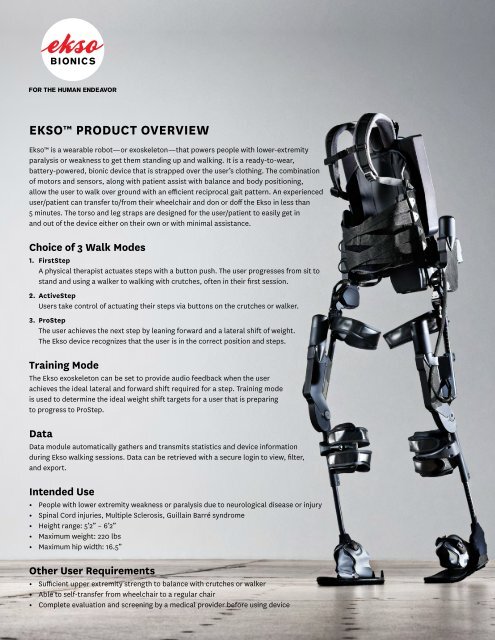EKSo™ Product ovErviEw - Ekso Bionics
EKSo™ Product ovErviEw - Ekso Bionics
EKSo™ Product ovErviEw - Ekso Bionics
Create successful ePaper yourself
Turn your PDF publications into a flip-book with our unique Google optimized e-Paper software.
EKSo <strong>Product</strong> <strong>ovErviEw</strong><br />
<strong>Ekso</strong> is a wearable robot—or exoskeleton—that powers people with lower-extremity<br />
paralysis or weakness to get them standing up and walking. It is a ready-to-wear,<br />
battery-powered, bionic device that is strapped over the user’s clothing. The combination<br />
of motors and sensors, along with patient assist with balance and body positioning,<br />
allow the user to walk over ground with an efficient reciprocal gait pattern. An experienced<br />
user/patient can transfer to/from their wheelchair and don or doff the <strong>Ekso</strong> in less than<br />
5 minutes. The torso and leg straps are designed for the user/patient to easily get in<br />
and out of the device either on their own or with minimal assistance.<br />
choice of 3 walk Modes<br />
1. FirstStep<br />
A physical therapist actuates steps with a button push. The user progresses from sit to<br />
stand and using a walker to walking with crutches, often in their first session.<br />
2. ActiveStep<br />
Users take control of actuating their steps via buttons on the crutches or walker.<br />
3. ProStep<br />
The user achieves the next step by leaning forward and a lateral shift of weight.<br />
The <strong>Ekso</strong> device recognizes that the user is in the correct position and steps.<br />
training Mode<br />
The <strong>Ekso</strong> exoskeleton can be set to provide audio feedback when the user<br />
achieves the ideal lateral and forward shift required for a step. Training mode<br />
is used to determine the ideal weight shift targets for a user that is preparing<br />
to progress to ProStep.<br />
data<br />
Data module automatically gathers and transmits statistics and device information<br />
during <strong>Ekso</strong> walking sessions. Data can be retrieved with a secure login to view, filter,<br />
and export.<br />
intended use<br />
• People with lower extremity weakness or paralysis due to neurological disease or injury<br />
• Spinal Cord injuries, Multiple Sclerosis, Guillain Barré syndrome<br />
• Height range: 5’2” – 6’2”<br />
• Maximum weight: 220 lbs<br />
• Maximum hip width: 16.5”<br />
other user requirements<br />
• Sufficient upper extremity strength to balance with crutches or walker<br />
• Able to self-transfer from wheelchair to a regular chair<br />
• Complete evaluation and screening by a medical provider before using device
contraindication<br />
• Upper extremity strength deficits that limit the ability to balance with a front rolling walker or crutches<br />
• Spinal instability (or spinal orthotics unless cleared by a medical doctor)<br />
• Unresolved deep vein thrombosis (DVT)<br />
• Decreased standing tolerance due to orthostatic hypotension<br />
• Significant osteoporosis that prevents safe standing or may increase the risk of fracture caused by<br />
standing or walking<br />
• Range of motion (ROM) restrictions that would prevent a patient from achieving a normal, reciprocal<br />
gait pattern, or would restrict a patient from completing normal sit-to-stand or stand-to-sit transitions<br />
• Uncontrolled spasticity<br />
• Uncontrolled Autonomic Dysreflexia (AD)<br />
• Skin integrity issues on contact surfaces of the device<br />
• Skin integrity issues that would prohibit sitting<br />
• Cognitive impairments resulting in motor planning or impulsivity concerns<br />
• Pregnancy<br />
• Colostomy<br />
Spinal cord injuries usage chart<br />
Understanding that each center has a different infrastructure that will drive utilization,<br />
we have charted out potential areas of usage for both spinal cord injury patients and<br />
others with mobility limitations.<br />
iNcoMPLEtE Sci coMPLEtE Sci<br />
EXErciSE & wELLNESS ● ●<br />
rESEArcH ● ●<br />
GAit trAiNiNG ●<br />
PrEPArAtioN For<br />
PErSoNAL dEvicE ● ●<br />
other Potential Areas of usage<br />
Neurological disorders such as Guillain Barré, MS, ALS, Parkinson’s<br />
disease and other diagnosis may benefit from gait training with <strong>Ekso</strong><br />
if all inclusion criteria are met.<br />
<strong>Ekso</strong> offers a wide variety of research opportunities with SCI and<br />
other diagnostic groups.<br />
For sales information, please contact Anne Chechile at<br />
CustomerRelations@eksobionics.com.<br />
1414 Harbour way South, Suite 1201 richmond, cA 94804 o. 510.984.1761 f. 510.927.2647 eksobionics.com


